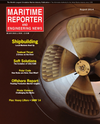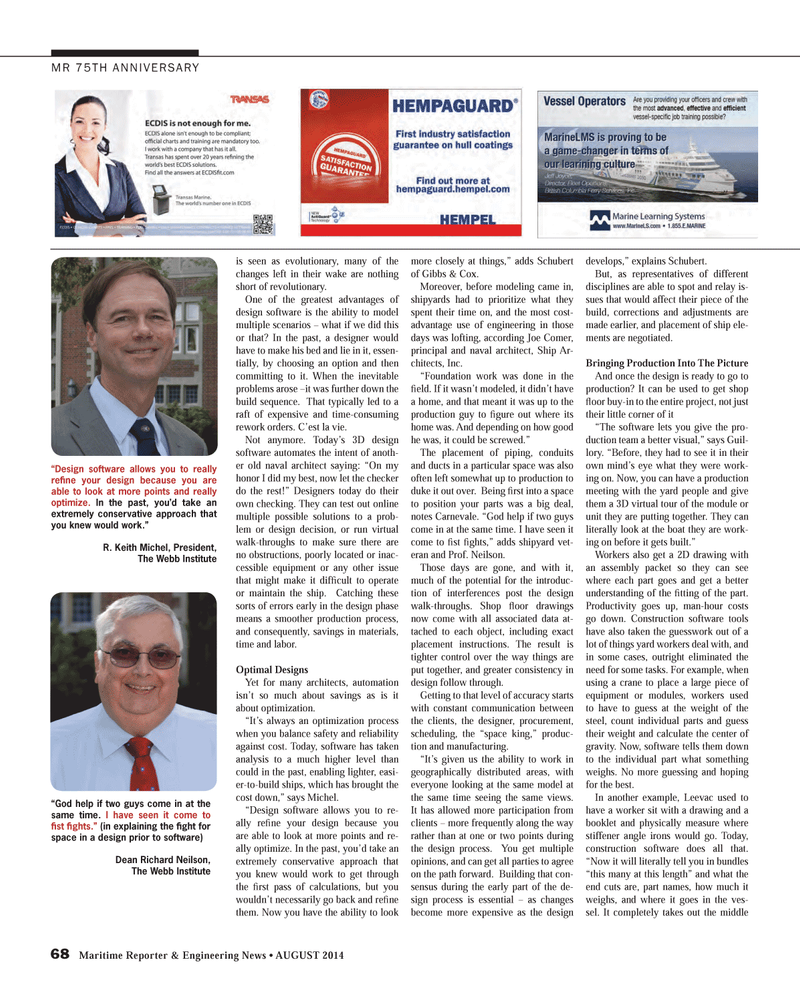
Page 68: of Maritime Reporter Magazine (August 2014)
Shipyard Edition
Read this page in Pdf, Flash or Html5 edition of August 2014 Maritime Reporter Magazine
68 Maritime Reporter & Engineering News ? AUGUST 2014 MR 75TH ANNIVERSARY is seen as evolutionary, many of the changes left in their wake are nothing short of revolutionary. One of the greatest advantages of design software is the ability to model multiple scenarios ? what if we did this or that? In the past, a designer would have to make his bed and lie in it, essen-tially, by choosing an option and then committing to it. When the inevitable problems arose ?it was further down the build sequence. That typically led to a raft of expensive and time-consuming rework orders. C?est la vie. Not anymore. Today?s 3D design software automates the intent of anoth-er old naval architect saying: ?On my honor I did my best, now let the checker do the rest!? Designers today do their own checking. They can test out online multiple possible solutions to a prob-lem or design decision, or run virtual walk-throughs to make sure there are no obstructions, poorly located or inac-cessible equipment or any other issue that might make it difÞ cult to operate or maintain the ship. Catching these sorts of errors early in the design phase means a smoother production process, and consequently, savings in materials, time and labor. Optimal Designs Yet for many architects, automation isn?t so much about savings as is it about optimization. ?It?s always an optimization process when you balance safety and reliability against cost. Today, software has taken analysis to a much higher level than could in the past, enabling lighter, easi- er-to-build ships, which has brought the cost down,? says Michel. ?Design software allows you to re-ally reÞ ne your design because you are able to look at more points and re-ally optimize. In the past, you?d take an extremely conservative approach that you knew would work to get through the Þ rst pass of calculations, but you wouldn?t necessarily go back and re Þ ne them. Now you have the ability to look more closely at things,? adds Schubert of Gibbs & Cox.Moreover, before modeling came in, shipyards had to prioritize what they spent their time on, and the most cost-advantage use of engineering in those days was lofting, according Joe Comer, principal and naval architect, Ship Ar- chitects, Inc.?Foundation work was done in the Þ eld. If it wasn?t modeled, it didn?t have a home, and that meant it was up to the production guy to Þ gure out where its home was. And depending on how good he was, it could be screwed.?The placement of piping, conduits and ducts in a particular space was also often left somewhat up to production to duke it out over. Being Þ rst into a space to position your parts was a big deal, notes Carnevale. ?God help if two guys come in at the same time. I have seen it come to Þ st Þ ghts,? adds shipyard vet- eran and Prof. Neilson.Those days are gone, and with it, much of the potential for the introduc-tion of interferences post the design walk-throughs. Shop ß oor drawings now come with all associated data at-tached to each object, including exact placement instructions. The result is tighter control over the way things are put together, and greater consistency in design follow through. Getting to that level of accuracy starts with constant communication between the clients, the designer, procurement, scheduling, the ?space king,? produc-tion and manufacturing. ?It?s given us the ability to work in geographically distributed areas, with everyone looking at the same model at the same time seeing the same views. It has allowed more participation from clients ? more frequently along the way rather than at one or two points during the design process. You get multiple opinions, and can get all parties to agree on the path forward. Building that con-sensus during the early part of the de-sign process is essential ? as changes become more expensive as the design develops,? explains Schubert.But, as representatives of different disciplines are able to spot and relay is-sues that would affect their piece of the build, corrections and adjustments are made earlier, and placement of ship ele- ments are negotiated. Bringing Production Into The Picture And once the design is ready to go to production? It can be used to get shop ß oor buy-in to the entire project, not just their little corner of it ?The software lets you give the pro-duction team a better visual,? says Guil-lory. ?Before, they had to see it in their own mind?s eye what they were work- ing on. Now, you can have a production meeting with the yard people and give them a 3D virtual tour of the module or unit they are putting together. They can literally look at the boat they are work-ing on before it gets built.?Workers also get a 2D drawing with an assembly packet so they can see where each part goes and get a better understanding of the Þ tting of the part. Productivity goes up, man-hour costs go down. Construction software tools have also taken the guesswork out of a lot of things yard workers deal with, and in some cases, outright eliminated the need for some tasks. For example, when using a crane to place a large piece of equipment or modules, workers used to have to guess at the weight of the steel, count individual parts and guess their weight and calculate the center of gravity. Now, software tells them down to the individual part what something weighs. No more guessing and hoping for the best.In another example, Leevac used to have a worker sit with a drawing and a booklet and physically measure where stiffener angle irons would go. Today, construction software does all that. ?Now it will literally tell you in bundles ?this many at this length? and what the end cuts are, part names, how much it weighs, and where it goes in the ves-sel. It completely takes out the middle ?Design software allows you to really re ne your design because you are able to look at more points and really optimize. In the past, you?d take an extremely conservative approach that you knew would work.?R. Keith Michel, President, The Webb Institute ?God help if two guys come in at the same time. I have seen it come to st ghts.? (in explaining the ght for space in a design prior to software) Dean Richard Neilson, The Webb Institute MR #8 (64-73).indd 68MR #8 (64-73).indd 688/7/2014 9:45:26 AM8/7/2014 9:45:26 AM

 67
67

 69
69
